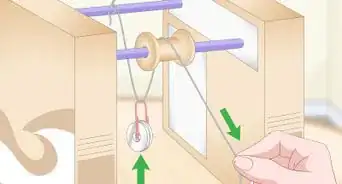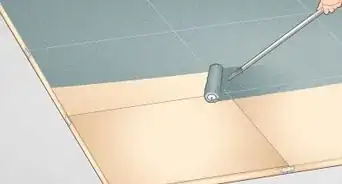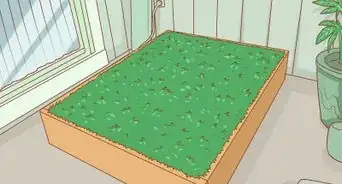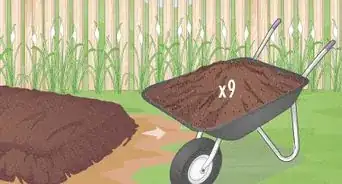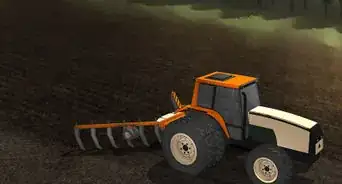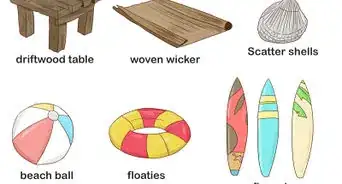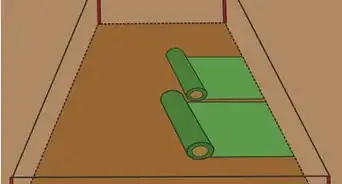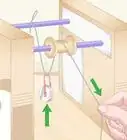This article was co-authored by wikiHow Staff. Our trained team of editors and researchers validate articles for accuracy and comprehensiveness. wikiHow's Content Management Team carefully monitors the work from our editorial staff to ensure that each article is backed by trusted research and meets our high quality standards.
This article has been viewed 168,643 times.
Learn more...
Sinkholes develop when soft rock underground—e.g., limestone, gypsum, or other carbonate rock—wears away over time. This is known as “karst” terrain. Eventually, the unsupported sediment above the underground hole collapses, leaving the sinkhole open.[1] Typically, property owners don’t realize that their houses are built on karst terrain, and so sinkholes appear unexpectedly and without warning. To fill a sinkhole, you’ll first need to pour a concrete plug in the bottom of the hole. Then, fill the rest of the sinkhole with clay sand and top it off with a layer of topsoil.
Steps
Measuring the Sinkhole
-
1Monitor the hole to see if it grows. Sinkholes are often triggered by weather phenomena, such as a heavy rainstorm. Once a sinkhole has formed, though, it can continue to grow, as further portions of limestone or other carbonate rocks fall away. As long as a sinkhole continues to grow on a day-by-day basis, do not attempt to fill it in.[2]
- Once the sinkhole has stopped growing and remained the same size for a few days, you can fill it in.
-
2Probe the size and depth of the sinkhole. Only relatively small, shallow sink-holes can be filled by homeowners. Take a pole or stick (even a tree branch would do), and probe around in the sinkhole. Note how deep and wide it is.[3]
- Exercise caution when walking around the edge of the sinkhole! The ground can be very unstable, so take care not to fall.
- Do not attempt to fill in a sinkhole larger than 3 feet (0.91 m) in diameter.[4] Large sinkholes can be deep and potentially dangerous.
- If the sinkhole is deeper than chest height, do not step down inside of it. Deep sinkholes, and holes with steep walls, pose a high risk of collapse.[5]
Advertisement -
3Call a professional landscaping company. If you’re concerned about working in and around a sinkhole, or if you think that the sinkhole is too large for you to fill, it’s time to call professionals. Use Internet resources to find a local landscaping company, and explain that you’re hoping to have a sinkhole on your property filled in.[6]
- Landscaping companies will have more experience in dealing with this phenomenon than the average homeowner.
- When dealing with very large sinkholes, you’ll need to contact local authorities in the city or county in which the sinkhole has appeared.
Pouring a Concrete Plug
-
1Dig out the outer edges of the sinkhole. The sinkhole may be larger underground than it appears on the surface. To determine the true extent of the sinkhole, use a shovel to expand the size of the sinkhole. Remove the sod around the edges of the sinkhole and make sure the surrounding ground is solid. Continue to remove the edges of the hole until you reach a point at which the topsoil and sediment are supported by solid rock.[7]
- Also remove any loose debris that may be in the sinkhole: tree branches, pinecones, etc.
-
2Mix dry concrete powder with water. Start out by pouring about a third of the concrete mix into a large basin, such as a wheelbarrow. Pour in about 1 US-quart (946 ml) of water, and mix thoroughly with a hoe, shovel, or paddle mixer. Continue to add water until the concrete is wet throughout and a heavy putty consistency. Add gravel for increase the strength of the concrete.[8]
- You can buy 80-pound (36 kg) bags of quick-mixing concrete at your local hardware store or home-supply store.
- The size and depth of the sinkhole will determine how much concrete you need to mix.
-
3Pour a concrete plug in the sinkhole. Using the wheelbarrow and the shovel, pour wet concrete into the bottom of the sinkhole. This will prevent the sinkhole from deepening further, and will give a solid base to the subsequent materials you use to fill the hole.[9] Aim to fill at least a quarter of the hole with concrete. So, if the sinkhole is 4 feet (1.2 m) deep, fill it with 1 foot (0.3 m) of concrete.
- You do not need to let the concrete dry before you move on to filling the hole with sand and soil.
- A “plug” simply means that you’ll fully fill the bottom of the sinkhole with concrete.
Filling the Sinkhole
-
1Add clay sand on top of the concrete plug. Thick, clayey sand will provide a heavy filling for the sinkhole which prevents water from collecting in the re-filled sinkhole. Using your shovel, scoop the sand out of a wheelbarrow or truck bed and deposit it into the hole.[10] Fill the hole with sand until it’s about ¾ full.
- Sand can be purchased at most large hardware stores, home-supply stores, or landscape-supply stores. If none of these venues sell clayey sand, contact a building contractor in your area.
- Most contracting companies will have a sand supplier that they may put you in touch with.
-
2Fill the hole with topsoil. Fill whatever depth remains to the sinkhole with topsoil. This will bring the materials you used to fill the hole up to the level of the surrounding yard or terrain. Finishing the hole with topsoil will also allow plants to grow on top of the former sinkhole and stabilize the soil and sand.[11]
- Topsoil can be purchased by the bag at any gardening center or home-supply store.
-
3Top off the hole with more soil in a few days. Over time, the sand and topsoil that you’ve added to the sinkhole will compact and settle. This will leave open room at the top of the sinkhole again. Use the rest of the topsoil to fill in the hole until it’s once again at the level of the surrounding terrain.[12]
- Repeat this process more than once, if necessary. The materials filling the sinkhole are likely to settle following heavy rain or runoff.
- Avoid planting trees or shrubs over the sinkhole as the may not thrive due to a lack of nutrients in the soil. They could also become uprooted or fall if the hole collapses again.
Community Q&A
-
QuestionWhat do I do if the sinkhole swallows up my house?
 Mr.bekfastmanCommunity AnswerTry to get out of the house as fast as possible. If you are not near an exit, cover your head with something hard.
Mr.bekfastmanCommunity AnswerTry to get out of the house as fast as possible. If you are not near an exit, cover your head with something hard. -
QuestionCan I just fill it with dirt and if I can't, why?
 k001 k1dCommunity AnswerYes ,you can fill it with dirt. Try something with rocks in it to help make it more solid.
k001 k1dCommunity AnswerYes ,you can fill it with dirt. Try something with rocks in it to help make it more solid.
Warnings
- Notify the police immediately if you notice a sinkhole on public property, such as a parking lot or roadway. If you can, stay near the sinkhole (such as parking your car near, but not too close to, the hole with the hazard lights on) until help arrives to prevent other people or vehicles from potentially falling in the hole.⧼thumbs_response⧽
- If a sinkhole is threatening your house (or another structure), evacuate immediately. Sinkholes can grow without warning, and your top priority should be the safety of yourself and your family.[14]⧼thumbs_response⧽
- Ensure the sink hole is not caused by a broken pipe or water leak. If the inside of the hole is wet or smells foul, take steps to remedy the problem before attempting to fill the sinkhole.⧼thumbs_response⧽
References
- ↑ http://www.popularmechanics.com/adventure/outdoors/tips/a9192/why-sinkholes-appear-and-how-to-fix-them-15704756/
- ↑ http://www.popularmechanics.com/adventure/outdoors/tips/a9192/why-sinkholes-appear-and-how-to-fix-them-15704756/
- ↑ http://www.earthtech.com/residential/sinkhole-truth/best-sinkhole-repair-methods/
- ↑ http://www.popularmechanics.com/adventure/outdoors/tips/a9192/why-sinkholes-appear-and-how-to-fix-them-15704756/
- ↑ https://www.fairfaxcounty.gov/nvswcd/drainageproblem/sinkhole.htm
- ↑ https://www.fairfaxcounty.gov/nvswcd/drainageproblem/sinkhole.htm
- ↑ http://homeguides.sfgate.com/repair-sinkholes-backyard-37017.html
- ↑ https://www.familyhandyman.com/masonry/pouring-concrete/how-to-properly-mix-concrete/view-all/
- ↑ http://www.popularmechanics.com/adventure/outdoors/tips/a9192/why-sinkholes-appear-and-how-to-fix-them-15704756/
- ↑ http://www.popularmechanics.com/adventure/outdoors/tips/a9192/why-sinkholes-appear-and-how-to-fix-them-15704756/
- ↑ http://www.popularmechanics.com/adventure/outdoors/tips/a9192/why-sinkholes-appear-and-how-to-fix-them-15704756/
- ↑ http://homeguides.sfgate.com/repair-sinkholes-backyard-37017.html
- ↑ http://www.popularmechanics.com/adventure/outdoors/tips/a9192/why-sinkholes-appear-and-how-to-fix-them-15704756/
- ↑ http://www.popularmechanics.com/adventure/outdoors/tips/a9192/why-sinkholes-appear-and-how-to-fix-them-15704756/
About This Article
You can fix a sinkhole by pouring concrete into it to plug it up and then filling it with clay sand and dirt. Mix concrete in a large basin or wheelbarrow by adding water to the dry concrete powder until it reaches a heavy putty consistency. Then, pour the concrete into the sinkhole to fill at least a quarter of the hole. After that, add thick clay sand on top of the concrete plug to provide a heavy filling that will keep water from collecting in the sinkhole. Fill the hole about ¾ of the way full with the clay sand. Add topsoil to fill whatever depth remains in the sinkhole so the ground is level and plants can grow on top. For tips about how to probe the size and depth of the sinkhole to fix it, keep reading!











